Paul Tran - Engagineers
Engagineers: alumni engagement APP
This application idea culminates several other potential design solutions and fulfills the stakeholder need of incentivizing alumni to remain active with the GlobalTIES organization. It features a rewards program feature within the app providing active Global TIES discounts at local businesses, and incremental tiers encourage alumni to become more active to earn more rewards while also allowing users to remain up to date on GlobalTIES news and information.

user research, user interview, market research, persona, wireframing, prototyping, wizard of oz mock-up
Discover
Design Challenge
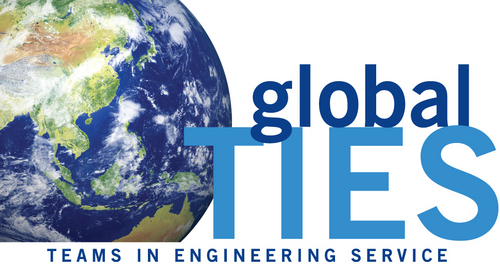
Global TIES is an organization that seeks to provides students with the opportunity to work together with local organizations in San Diego and those around the world, providing solutions for problems immediately relevant to those in need. However once students in the Global TIES program leave and/or graduate, the Global TIES program loses contact with them because they only can reach them via their UC San Diego email, which is deactivated upon graduation. Thus having a solution to allow former students to remain in contact with the program will provide Global TIES with the potential of a vast alumni network which could be used as potential resource for incoming students. Through interviews with the Global TIES staff and former and current students in the Global TIES program we believe that the user needs some sort of way to connect with the Global TIES program as an alumni that is easy to use and incentives that are compelling enough that they would remain active as a Global TIES member.
Planning
Gantt Chart
In order to hit the ground running we created a Gantt Chart that organizes our key tasks and sets concrete goals and checkpoints to help us plan out the design process over a 10 week period.
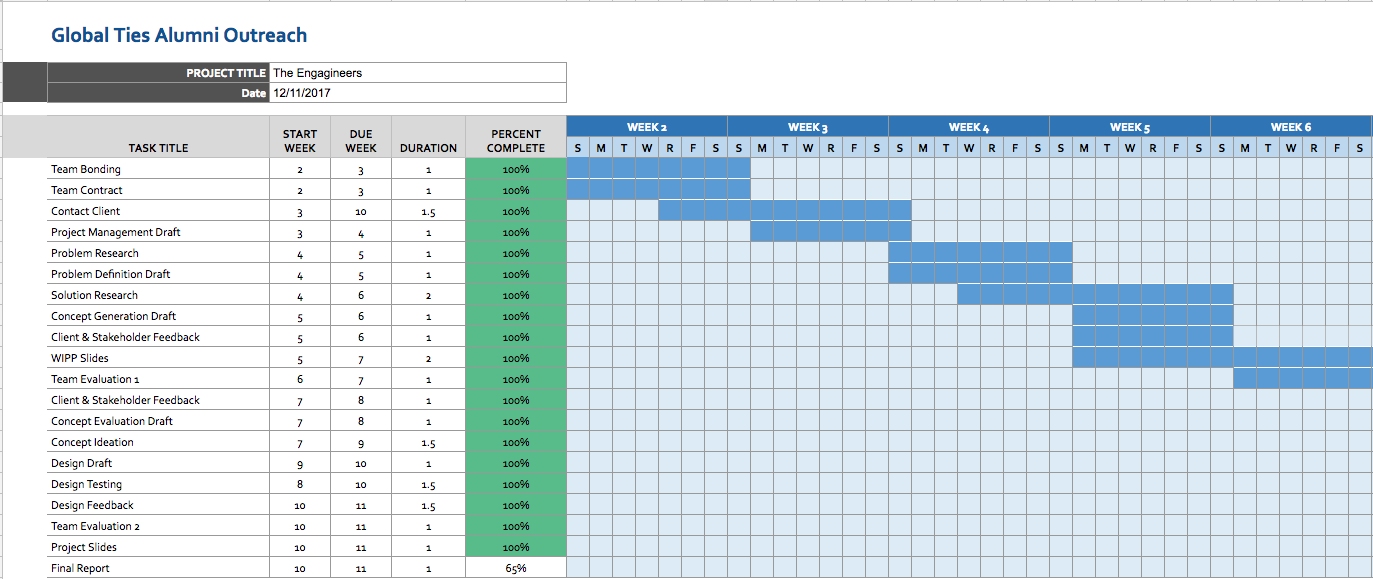
Network Chart
We also generated a Network Chart to visualize and map out critical paths in our design plan.
Research Plan
The plan for research is to find and reach out to the target user group. We will perform market research on similar applications, specifically those targetted at alumni. We will also use connectivity tools like LinkedIn and similar social media apps for inspiration. In terms of interviews, we will be asking a couple of warm-up questions regarding how long the person has been with the Global TIES program and what they’ve worked on. The main focus will be to figure out why they are not connected with the program more deeply. Here are some example questions:- How long have you been a part of the Global TIES program at UCSD?
- What have you worked on with Global TIES?
- What would you say is lacking with Global TIES in terms of resources, contacts, etc?
- Who do you keep in touch with after working on your project for Global TIES?
- Would you be interested in keeping in contact with alumni from the Global TIES? Why or why not?
- Do you think Global TIES should be promoted throughout UCSD more? Why or why not?
Stakeholder Analysis
- Brandon Reynante (Ally - High influence) The instructor for class END 100D and a UCSD alumni. As our instructor and an active member of Global TIES, Brandon will be a crucial stakeholder as we work on our project. We plan on keeping in close contact with him, to get feedback as we iterate on prototypes, to find more stakeholders, and to get general advice on project decisions. As the instructor who found the project for our team to work with and as someone who has much experience in project management, Brandon is someone who both high power and high interest in making this project succeed.
- Lin Hein (Ally - Low influence) A fourth-year electrical engineering student at UCSD. He has experience serving as Undergraduate Advisor from Fall 2016-17 and is currently a Fellow in Humanitarian Engineering. Lin will be our primary contact with other alumni and staffs. Being the primary contact with alumni, Lin has a lot of motivation to ensure that these alumni will remain connected with Global TIES going forward, and as such has high interest in our project.
- Diana Wu Wong (Ally - Low influence) Diana is a former Global TIES student and TA who previously worked on an alumni engagement initiative. Like Lin, she is able to help provide suggestions, but we are ultimately designing for alumni, thus power is lower.
- UCSD Global TIES Community (Ally - High influence) Global TIES Community include all of the current staff members and students that are and will potentially be interested in our project. They have relatively low interest as to how the design will turn out and not much say about the design given we are designing more for alumni and less for students.
- Global TIES Alumni and former staffs (Ally - Low influence) These are the people the Global TIES program yearns to connect with. As such, their opinion matters if we need to reach out to them, but they have low motivation to help.
Analysis Matrix
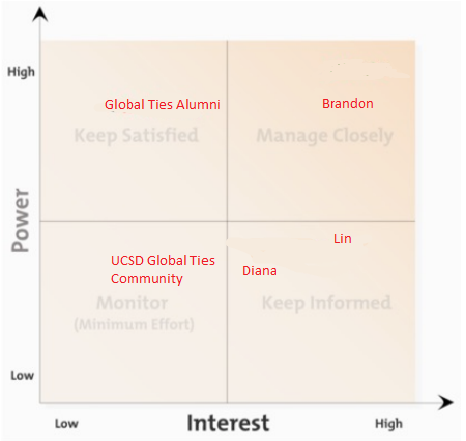
Define
Design Statement
Global TIES alumni needs a network of post-graduation support because the current Global TIES community lacks sufficient resources to with current students in the program and with other alumni.
Persona
From the information gained through the research with our stakeholders I put together the following personas to aid us in further defining our target user group.
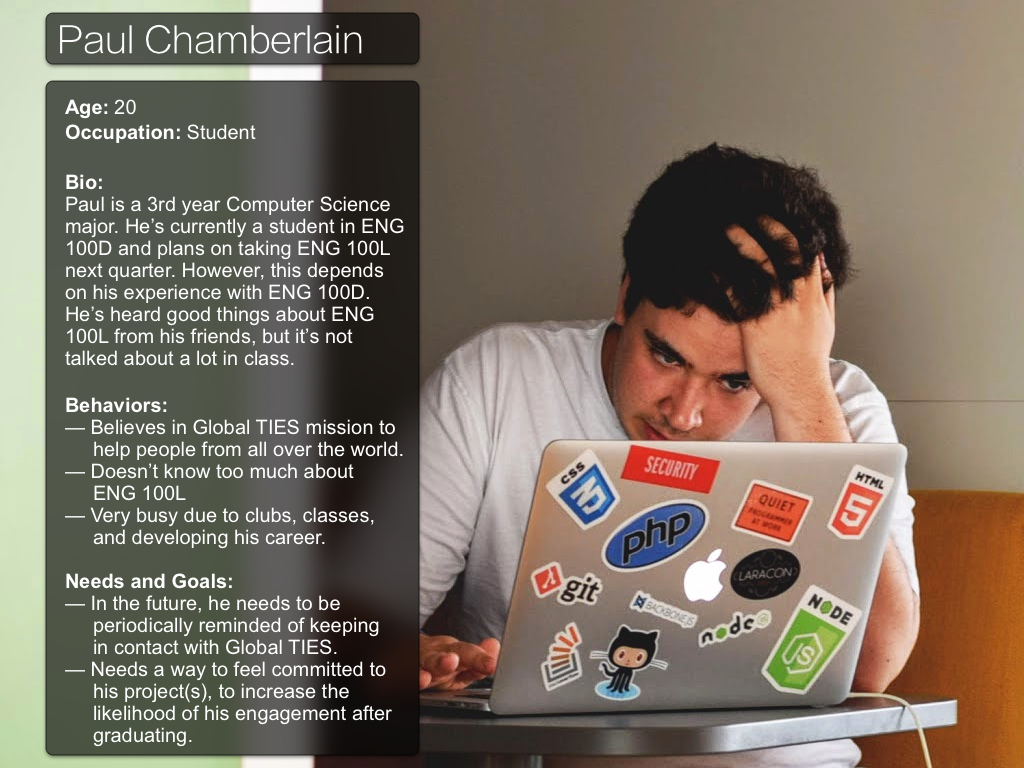
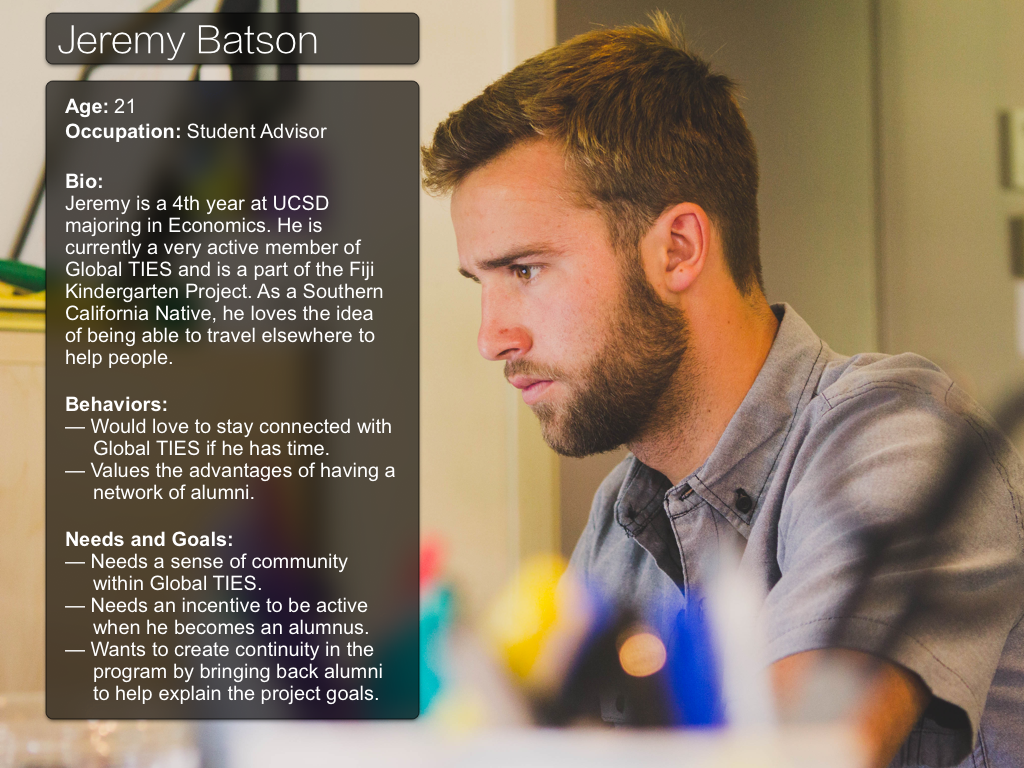
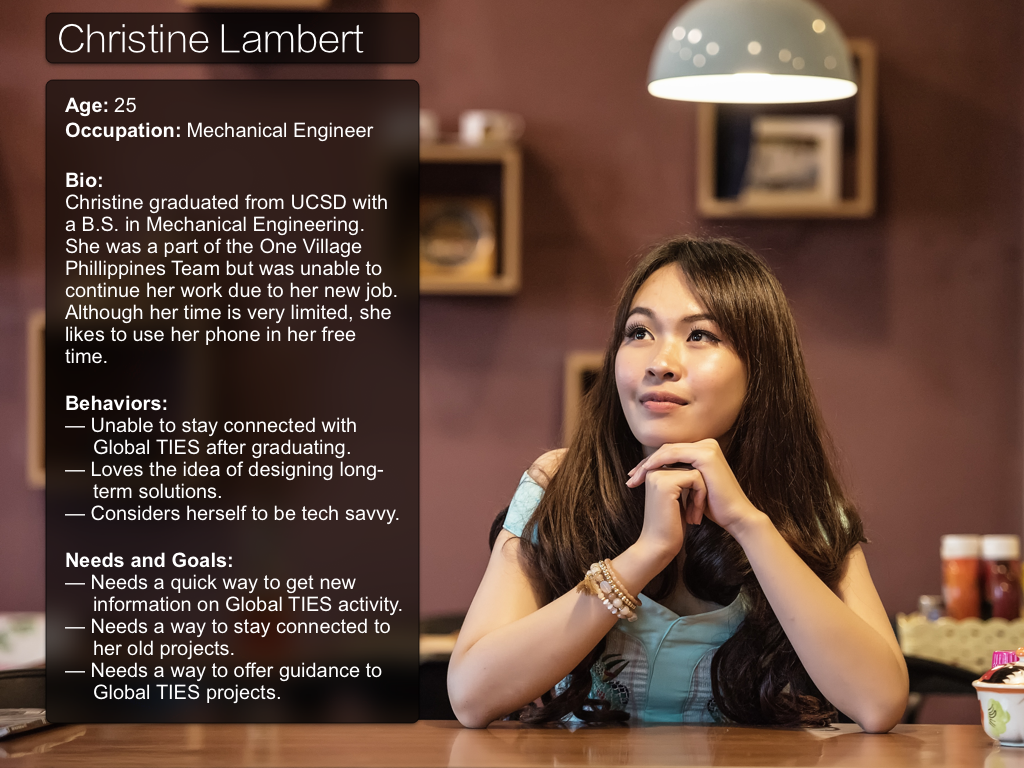
Needs and Insights
In conjunction with the personas we formed I developed an empathy map to further understand the target user group from a generalized perspective as and also created a list of need and insights that we must address.
empathy map
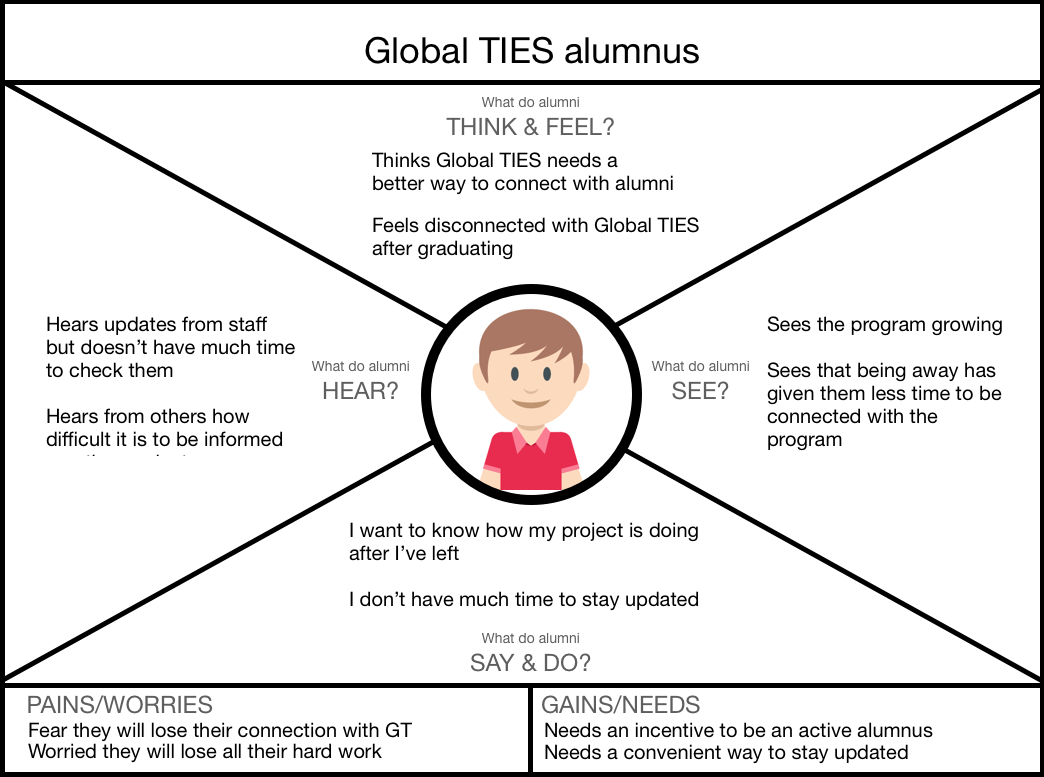
- A source of reliable and up-to-date information about the Community
- Some kind of incentive in the form of networking opportunities, achievements, events, or food/rewards that to go back to the community.
- A sense of purpose that their effort will make a change in people's life.
- See more connection between current Global TIES Teams.
Needs
- A platform that can closely in monitor UCSD Global TIES community to give the Alumni up-to-date info about the community is needed to keep/engage them.
- A form of incentive program is need to boost engagement at this stage - could be through free rewards, free dinner, etc.
- A good marketing campaign that can show alumni how beneficial their career and personal growth could be if they are active in the community
- A good base of Global TIES where current members are well informed of other’s projects so that when Alumni look at them, they really feel a sense of community and want to join.
Insights
Research
Market analysis
In order to best serve our stakeholders in addressing their problem, we needed to gain insight into existing designs through market analysis.
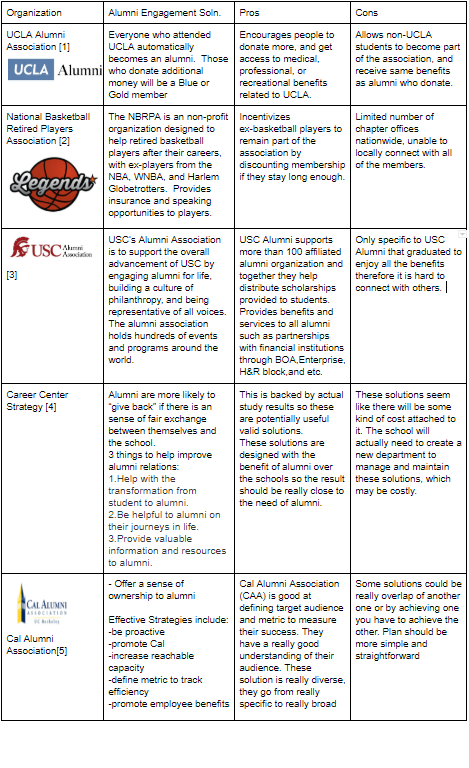
User Interviews
I compiled a list of contact information for alumni of the GlobalTIES program as well as current participants of the program and attempted to contact them in order to conduct interviews which would grant us further understanding of the user needs. I followed the guidelines we put together on the User Reserch Plan shown earlier.
Example Interview
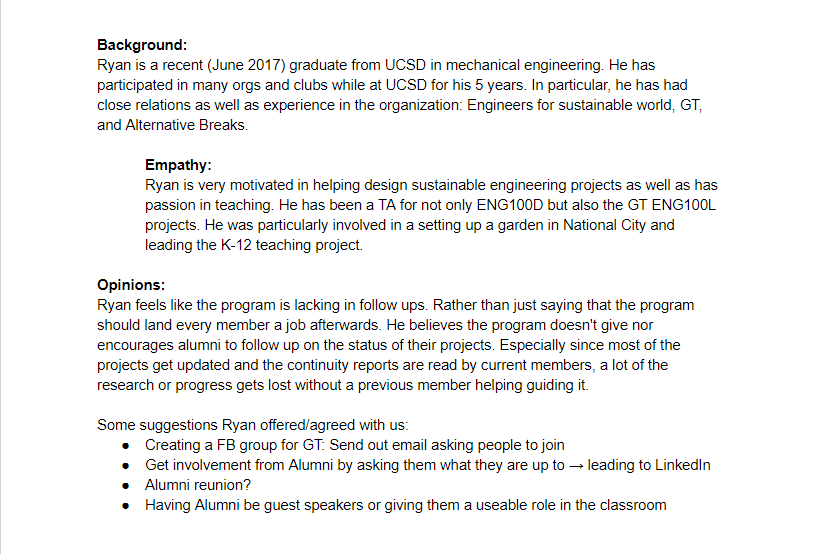
Design requirements
From our conversations with stakeholders, what we learned through market analysis, and the user interviews we performed we were able to establish the following design requirements.
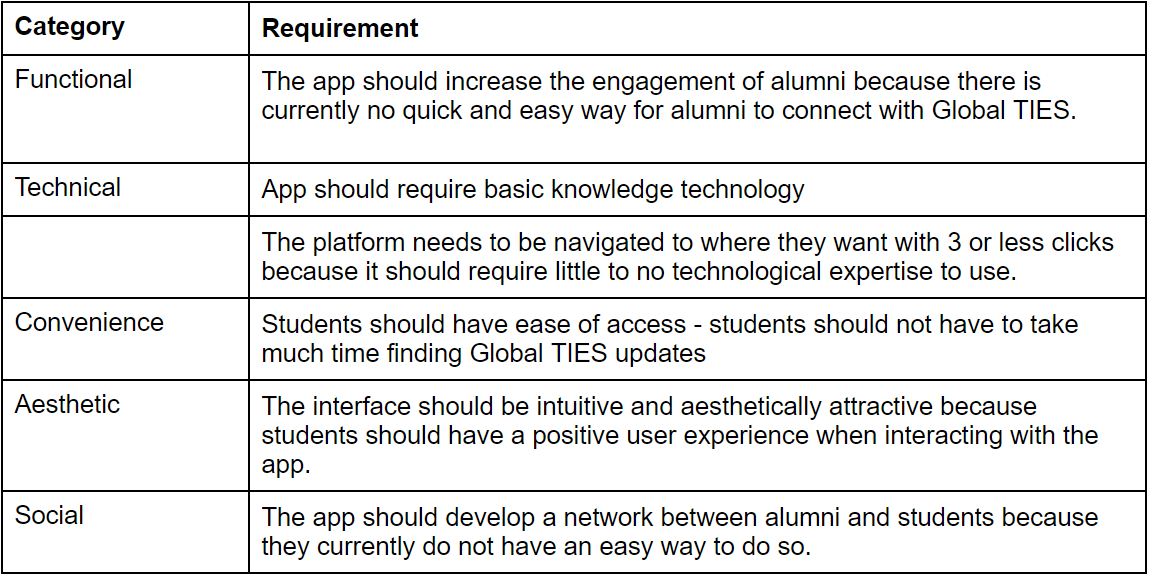
Develop
Concept Generation
Newsletter
Core Needs: Alumni are not up to date with Global TIES news.
- Strengths: It is versatile and easy to use. You can customize each issue you send, and it can be personalized for the Alumni. It can relate to emotions if you feature an alumni, but also can include project updates.
- Weaknesses: There isn't much activity from Global TIES that is being featured in the news or getting buzz. There is currently no direct line from alumni to GT to get information on their projects/achievements
Alumni Website
Core Needs: Alumni need a place to access news and information in order to stay engaged with Global TIES.
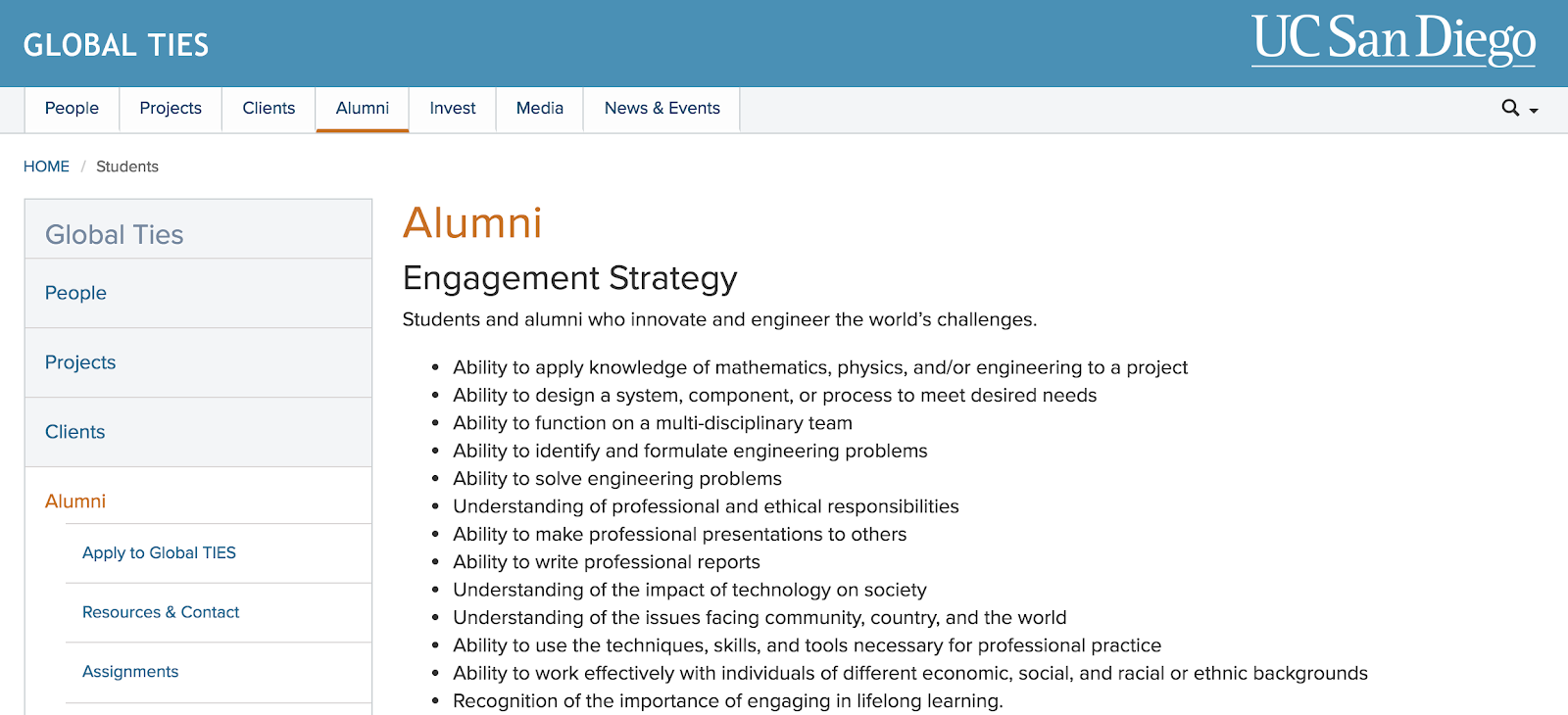
- Strengths: Alumni section would be fully integrated into the Global TIES website, something most alumni would already be familiar with. Alumni section would be continuous and would fit into the site feel and look. Do not have to build new infrastructure; can utilize the existing UCSD web network.
- Weaknesses: Requires the approval and communication of the webmaster. Can cause a delay in getting things done. Alumni are not usually inclined to usually visit the Global TIES site often. Does not track alumni information after graduation.
Social Media
Core Needs: Alumni need a way to receive frequent updates on Global TIES news through convenient means.
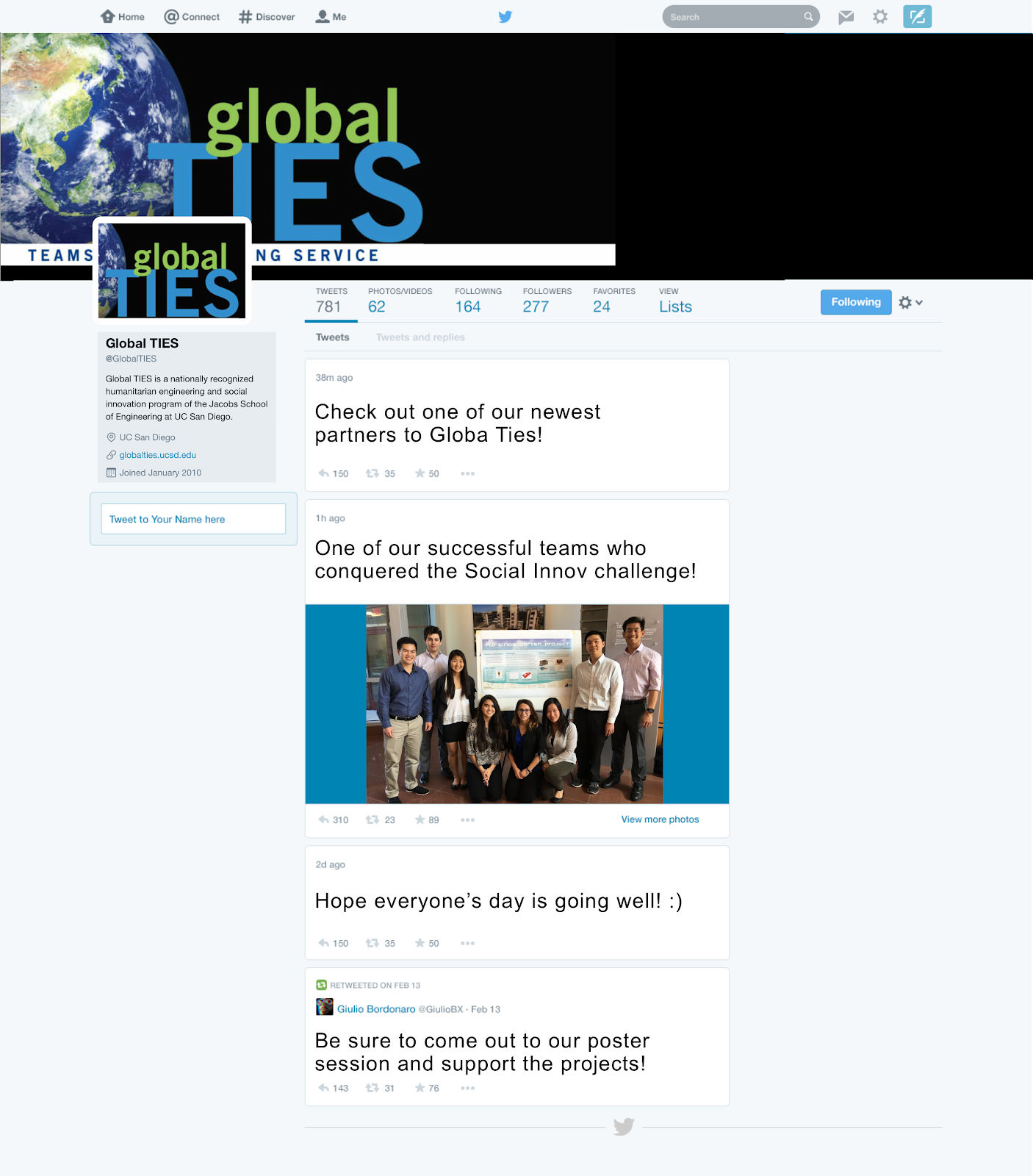
- Strengths: The user has a large amount of freedom in how they choose to access their updates and information. They are given flexibility in being able to choose what social media platform they want to use and in turn there is a low barrier to entry.
- Weaknesses: Multiple accounts must be updated and maintained. May be low in content if focused on alumni updates. General Global TIES posting would create clutter for alumni.
Mobile Application
Core Needs: Alumni are too busy to stay connected with Global TIES. They need a quick and convenient way to stay updated on news and events, so they can figure out how to contribute to the organization.
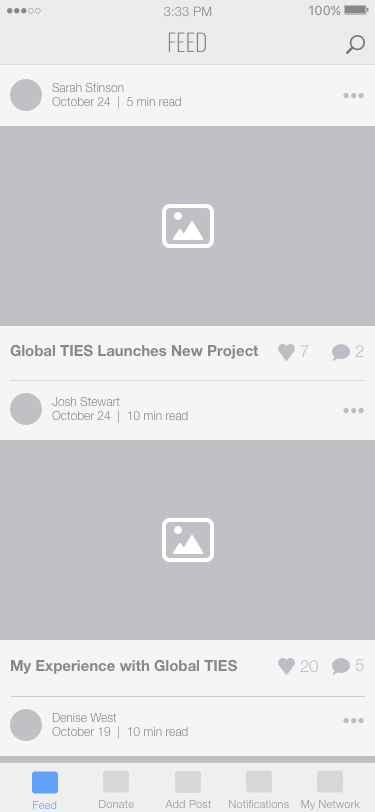
- Strengths: Convenient way for alumni to get updated information (without email spam). Allows alumni to connect with fellow alumni and current Global TIES students. Current students can reach out to alumni for guidance Alumni can personalize their notifications.
- Weaknesses: Requires resource intensive design and development. Would take a long time to launch because of the design process. Needs to be maintained and updated regularly.
Rewards Program
Core Needs: Alumni lack incentive for staying engaged with the Global TIES program. They need something to represent their contributions.
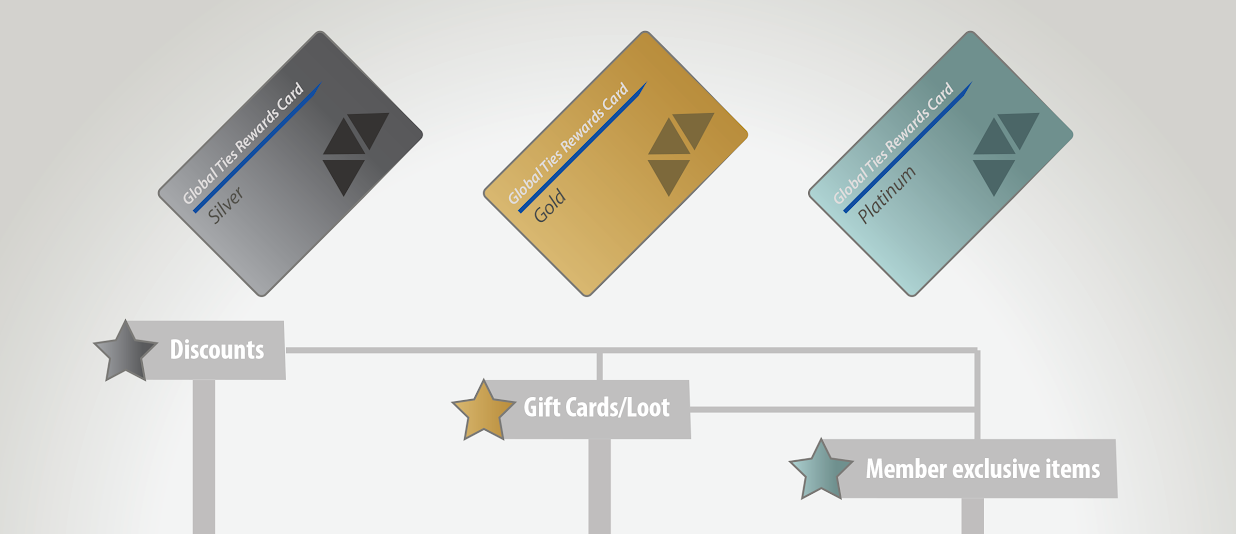
- Strengths: Alumni will be motivated to keep contributing to Global TIES. Provides representation to veterans of the program. Solution is simple, and straightforward for stakeholders to understand. Rewards are flexible, program is easy to modify. Program can be tailored to different types of individuals/
- Weakness: Program can be costly to run and maintain. Can be difficult to set up as it requires the approval and participation of outside companies. There are people who aren’t incentivized by the rewards that the program can give.
Concept Evaluation
We established a list of criteria using the information we gained from user research and mettings with our stakeholders. Using these criteria we evaluated each of our design concepts in order to narrow down the top concepts to expand on.
Criterion
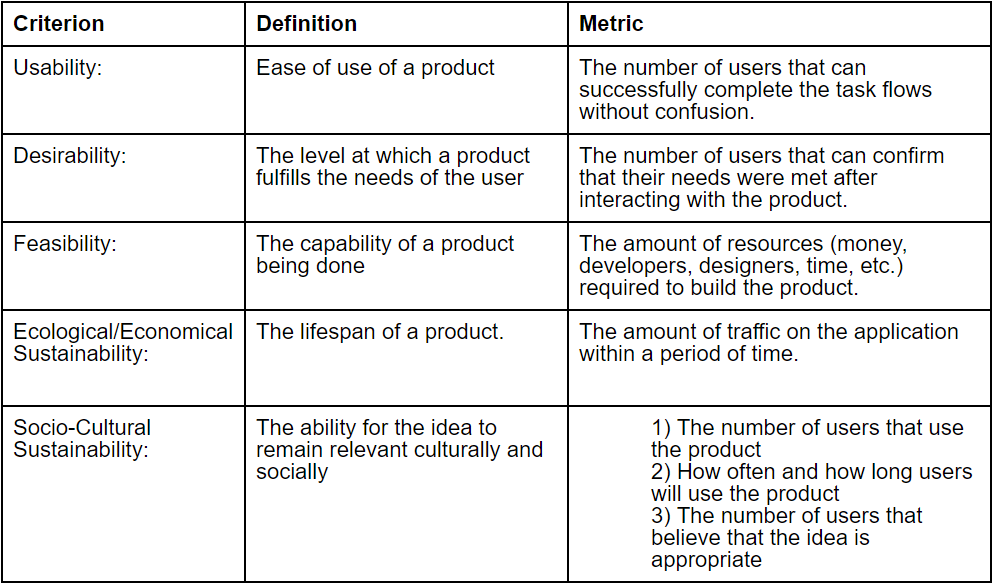
Evaluation Chart
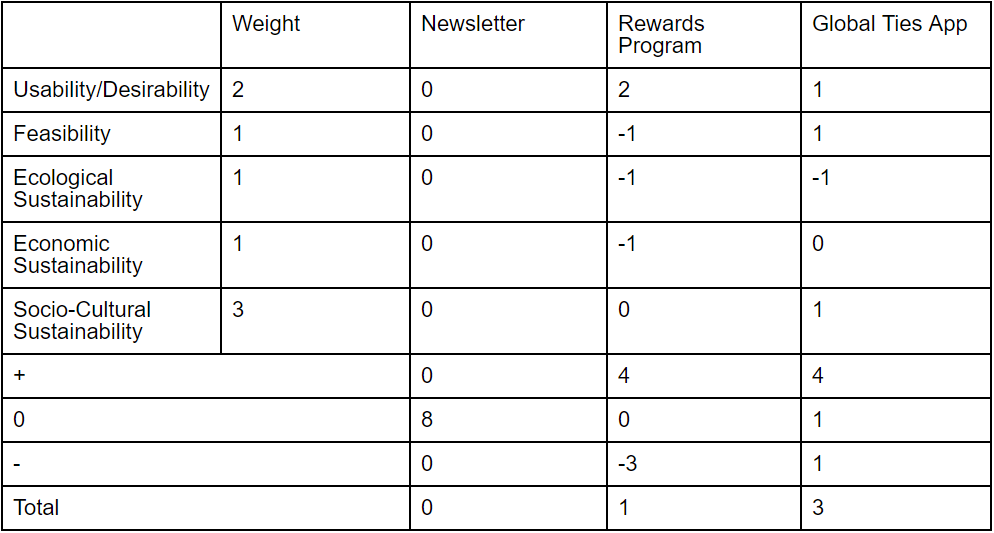
Prototyping
After evaluating our concepts we culminated several features into the application concept which rated most highly. Notably the rewards program, newsletter and an option to connect through social media.
User Flow
We established that the application would use a tab format where users can switch between pages, similar to Facebook or Twitter, with the following screens.
- Login Page: Users will have the option to use email or Google Account or LinkedIn to sign-up
- a feed page that have all of the new feeds on it (like Facebook), where you can view new stories and project being posted by your friends
- When you click on a feed show on page 2, this feed will expand and give you a more detail story about the feed for you to read
- Your reward membership overview, where you can find all of the instruction on how to earn reward and what kind of reward is available
- A scannable promo code for you convenience when you want to use your rewards
- A picture of how you can share and post your new feed for others to see
- Notifications where you can check to see if your have new friends request, any new likes or comment on your post.
- Your personal profile, the one that everyone will see when they click on your profile
- A continuation of the 8th page when all of your personal info is displaying in a clear format for people to see
Wireframes
With the user flow that we established I created the following wireframes so that we could better visualize our design solution.
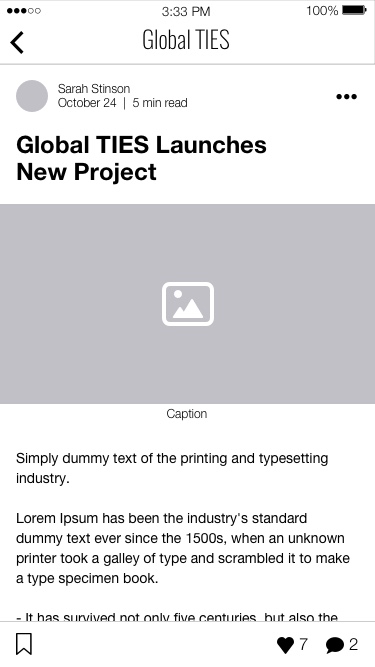
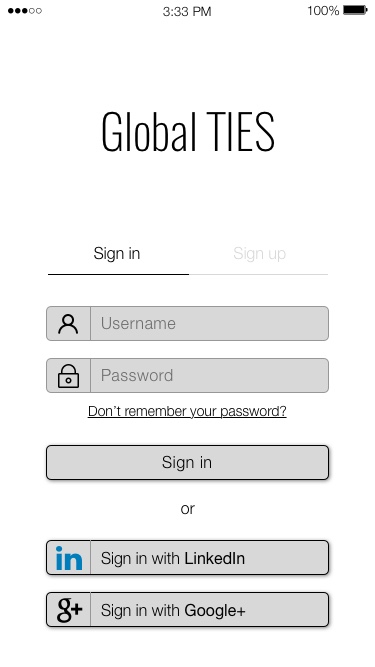
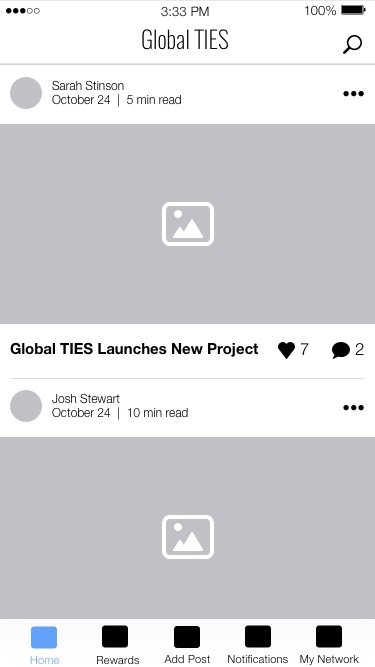
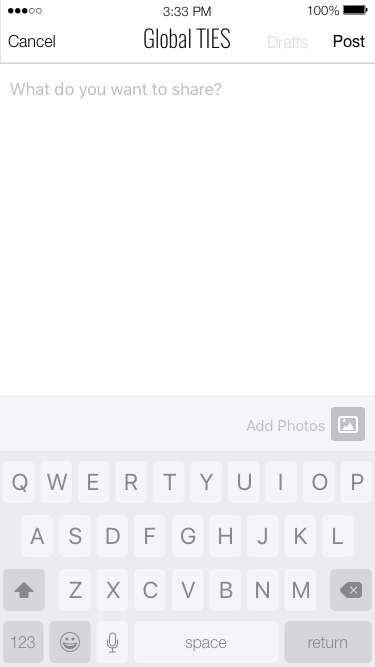
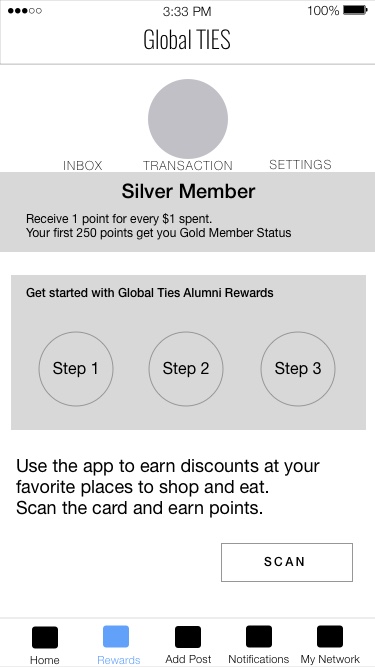
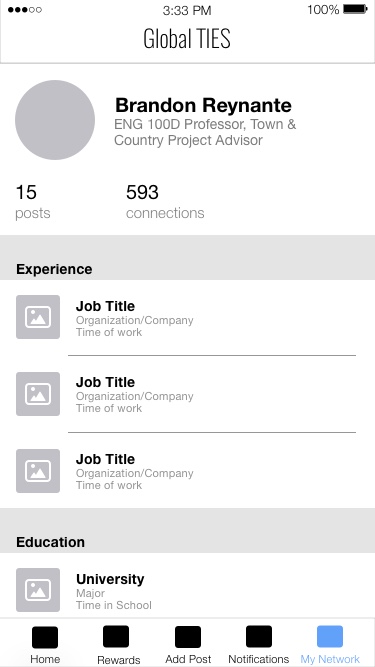
Stakeholder Feedback
Project Cost Breakdown
Together with stakeholders we compiled a breakdown estimating the implementation cost of our solution in order to gauge feasibility. It was determined to be a realistic solution by the GlobalTIES staff.
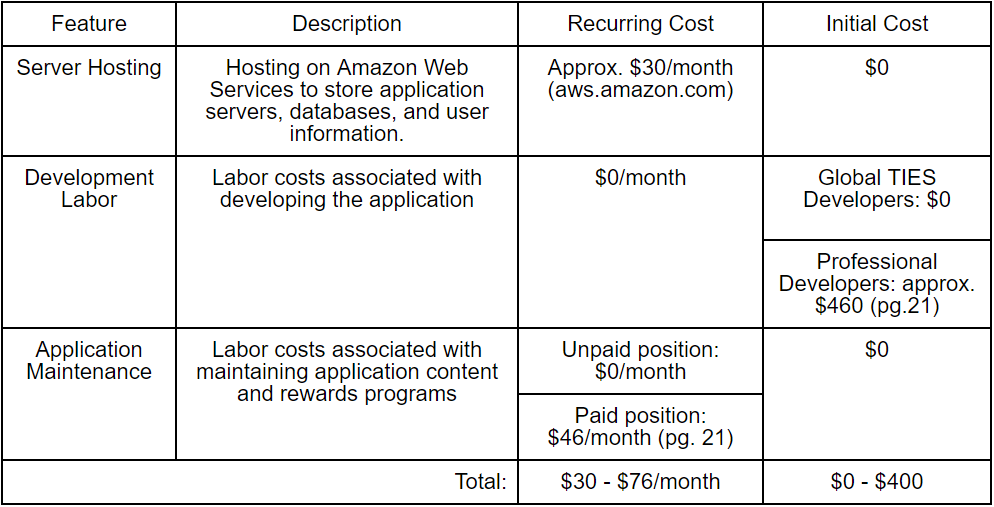
Deliver
Further Prototyping
A higher fidelity prototype was created in order to help us gain a better sense of how the application would look on a phone screen and work on a mock-up that can be tested and shown to stakeholders.

Using InVision we created a Wizard of Oz mockup to simulate the finished application which can be accessed below.

Implementation plan
Our design solution, because it is in the form of a mobile app, requires the expertise of software developers and Global TIES administrators in order to form an effective, robust, and maintainable solution. We estimate that it will take about two weeks to produce a minimum viable product if a team of developers is working about twenty hours a week, which comes out to forty hours total. They will need proper development environments and server space to host their app. Because the solution is a mobile app, teams will create the Alumni Engagement App for both Android and iOS phones. For Android phones, the main development environment will be Android Studio, while for iOS it will be XCode. Databases will be stored using mySQL, because it is maintainable and widely used by engineers. This app will have to be hosted on a server space, such as Amazon Web Services. These servers will be priced depending on the number of the users on the app, most likely less than $30/month (https://calculator.s3.amazonaws.com/index.html). The architecture of the application should be implemented as follows. Users will have the same set of front-end page templates, which will then be populated with the personal information of each Global TIES Alumni member. Each user will have their own account, whose information should be stored on a database on an encrypted server. The application will then pull data from that server any time the member’s account is updated. In addition to personal information, the Global TIES Alumni app will have a feed of updates where users will be updated of new events, such as a new project being started by alumni, newsletter features, or a new vendor in the rewards program. The algorithms to produce this information will be stored on the back-end servers as well, which will responsible for generating content, tracking app usage metrics, and generating codes for the rewards program.
Branding
For the name of the application we settled upon the name Engagineers for the application due to the mission of the GlobalTIES program encouraging "engineers" to "engage" with communities.
Logo
After experimenting with several designs I settled upon the following logo design, resenbling a shape with a wrench subtracted which symbolizes the "engineering" aspect. It is designed to be reminiscent of the letters "E" and "G".
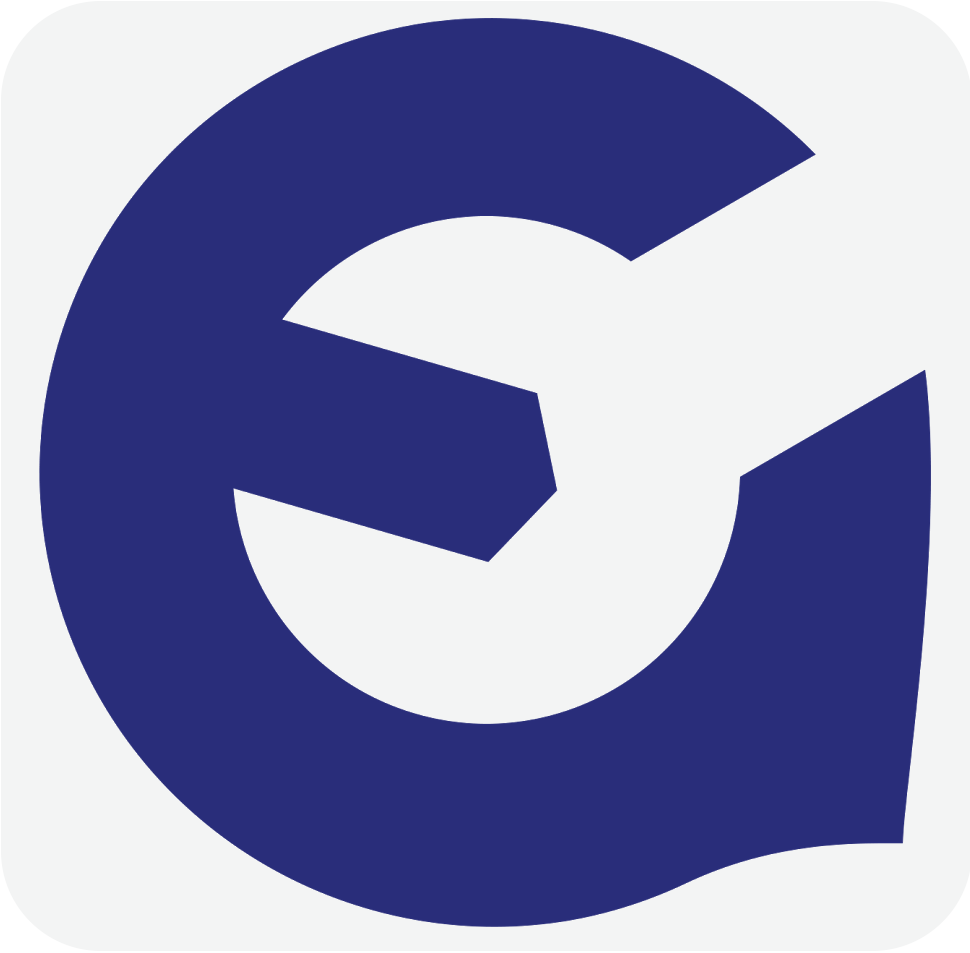
I designed an alternate logo should our stakeholders want to simply use the name of their organization, GlobalTIES.

Thoughts & Reflections
Out team worked together with the Global TIES staff team in order to tackle the issue regarding lack of alumni connections with former Global TIES students after their graduation. We believe that our final solution, a Global TIES mobile phone application, will allow Global TIES to remain a somewhat relevant part of the alumni’s life even as they leave the Global TIES program and UC San Diego. While this solution may not be the ultimate panacea to improving the Global TIES network, we believe that this will at least build up the trust between alumni and the program, which is key if the program wants to continue to reach out to these former students. Through interviews with Global TIES staff, current and former Global TIES students, we believe the key user needs for a solution include that some form of incentive system to reward the alumni for remaining involved with the Global TIES program, a way to build a network of current and former Global TIES staff and students, and a way to keep alumni up to date with current Global TIES projects. Our proposed solution, a mobile phone application was the culmination of several concept ideas originally proposed separately. This final application idea fulfills the user need of incentivizing users to remain active, as the included rewards program feature within the app provides active Global TIES discounts at local businesses, and several tiers encourage alumni to become more active to earn more rewards. The home page feed on the home tab of the app provides access to articles regarding current Global TIES projects so that users can stay up to date with the projects current Global TIES members are involved in. Lastly, the My Network tab in the application allows users to build their professional Global TIES network with current staff and alumni. The phone application is simple and its interface matches the interface of many other well known applications and should be relatively simple to use. Going forward, we believe that in order for the application to work towards improving alumni relations, alumni have to actually install the app on their phones in order for these relationships between alumni and the Global TIES program to form. One such way of doing this would be to heavily promote the app, through social media channels such as Facebook, Twitter, and LinkedIn. Global TIES could also consider encouraging current Global TIES students to install and log in to the application to ensure that when current students become alumni, Global TIES will already have these students’ contact information. We stress patience when rolling out the application to alumni and future students, as the Global TIES will have to build their alumni network from scratch.